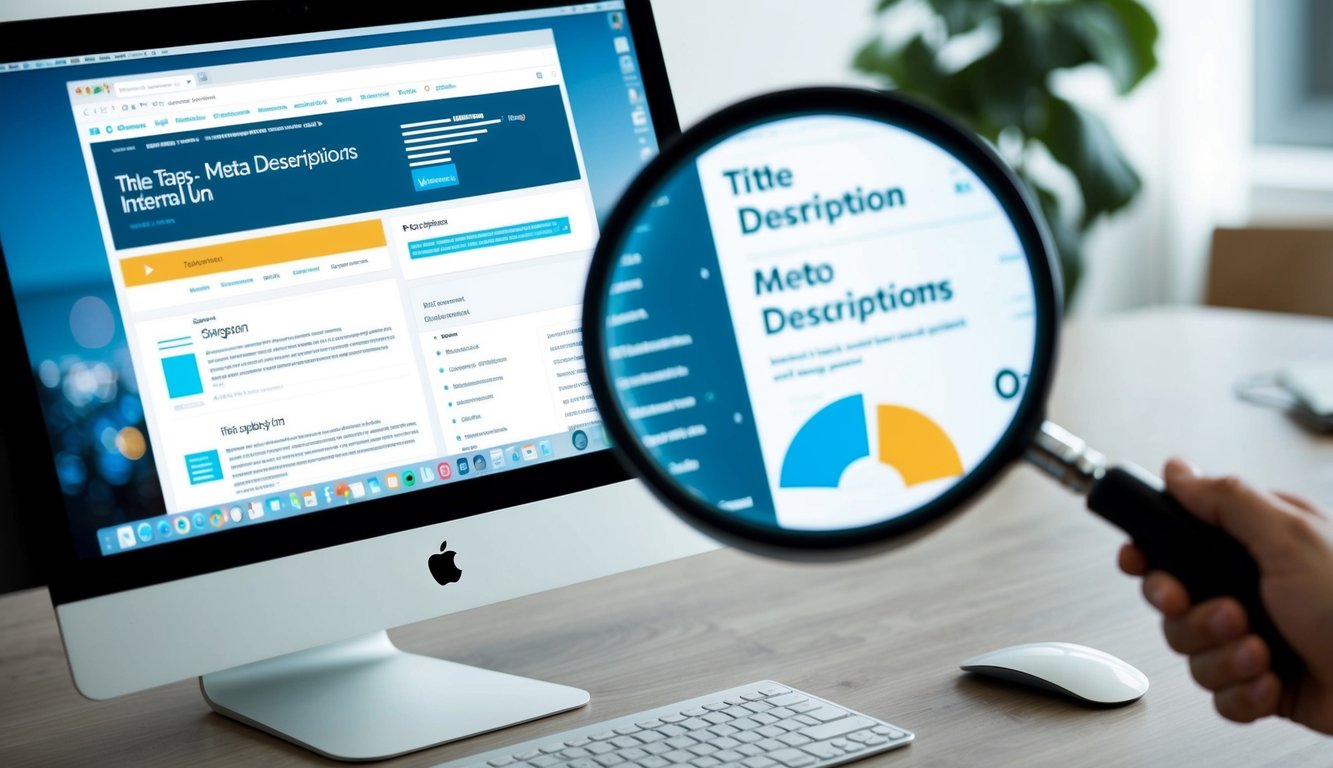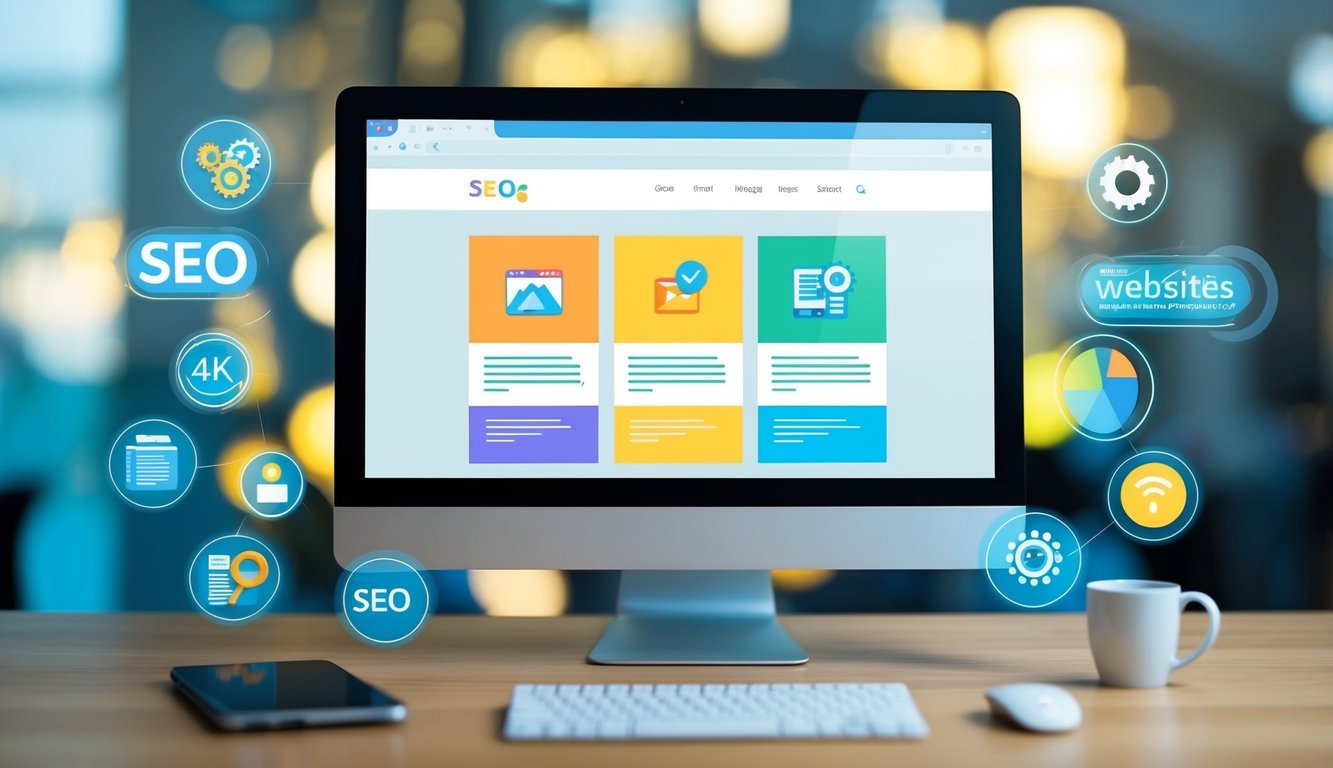Understanding On-Page SEO: Essential Elements for Optimizing Your Website
Deciphering the world of on-page SEO might feel like cracking an ancient code, but once you get the hang of it, optimization can propel your website to new heights.
Forget wandering in the digital wilderness; on-page SEO is about tuning your pages not just for the search engines, but also for the humans who visit them.
Mastering essential elements like title tags, meta descriptions, and internal linking will enhance your site’s visibility and user experience.

Your web page isn’t just a URL floating aimlessly in your browser; it’s prime real estate in the vast landscape of the internet.
On-page SEO is the magic that ensures your content is relevant, engaging, and accessible. It’s about aligning various elements like headers and content optimization to improve how both engines and users perceive your website’s value.
While off-page SEO gets the limelight, the unsung hero is on-page SEO, making sure your site isn’t just found but remembered.
A well-optimized page requires balancing several factors working in harmony, proving once again that the whole is indeed greater than the sum of its parts.
Key Takeaways
- On-page SEO enhances both search engine visibility and user experience.
- Elements like title tags and internal links are crucial for optimization.
- On-page factors must work together for maximum impact.
The Importance of On-Page SEO
Mastering on-page SEO is your golden ticket to optimizing your website, drawing in traffic, and climbing up those intimidating search engine rankings.
Ready to make Google notice you? Dive in, because this is where the magic happens.
Benefits for Website Optimization
You might think on-page SEO is just about tossing in a few keywords here and there. Think again!
It’s about sculpting your content to offer value and relevance to your audience. Keywords, for instance, are essential but only when they’re naturally woven into your narrative—not awkwardly shoved in like an ill-fitted shoe.
Title tags and meta descriptions do a powerful job of enticing clicks by giving searchers a sneak peek into your site’s content.
Clean URL structures and meaningful headings guide both search engines and users, building a navigable map through your pages.
Oh, and don’t forget quality images with descriptive alt text, adding that extra layer of accessibility and searchability.
Websites that are optimized well have snappy load times and seamless mobile experiences, keeping users engaged and craving more.
Impact on Search Engine Rankings
Ignoring on-page SEO? That’s a direct path to invisibility on the search engine results page.
When you polish your on-page elements, you’re aligning with algorithms designed to reward relevance and user satisfaction.
Search engines use E-E-A-T (Expertise, Experience, Authoritativeness, Trustworthiness) to gauge the quality of your content.
For you, this means ensuring content isn’t just keyword-rich but also authoritative and up-to-date.
Internal and external links are your digital reputation builders—they signal that you’re a part of a larger, trustworthy network of information.
So, well-placed links can boost your credibility and likeness in Google’s eyes.
The more you continue improving these elements, the closer you get to securing those coveted top spots in search results, welcoming visitors and potential customers to your site.
Key Elements of On-Page SEO
In the world of SEO, the details matter because they can make a big difference in how well your site performs.
You need to get the basics right: compelling and accurate title tags, meta descriptions that boost click-through rates, properly structured header tags, optimized content, and strategic internal linking.
Title Tags
Title tags are the unsung heroes of on-page SEO. A well-crafted title tag not only tells users what your page is about but also plays a crucial role in helping search engines understand your content.
Keep it under 60 characters to ensure it displays properly in search results.
Include your primary keyword near the start. This isn’t just a suggestion; it’s a must if you want to grab Google’s attention.
Don’t be vague. Use clear, engaging language that makes your audience click before they even realize it.
Meta Descriptions
Think of meta descriptions as your elevator pitch to searchers. A good one can boost your click-through rates by offering a compelling summary of the page content.
Aim for 155-160 characters to ensure it isn’t cut off in search results.
Incorporate a call to action. Encourage users to read more, learn more, or explore further.
Include your primary keywords but avoid keyword stuffing. Nobody clicks on something that reads like spam.
Header Tags
Header tags structure your content, and trust me, they’re way more important than they look.
Starting from <h1> down to <h6>, these tags help both users and search engines easily navigate your content. The <h1> should capture the main idea of your page.
The subheadings (<h2>, <h3>, etc.) should break down topics into digestible sections.
Proper use of header tags can improve readability and help you stuff in those keywords in a natural way. Just don’t overdo it. Google knows when you’re trying too hard.
Content Optimization
You guessed it, content is still king—for now.
Quality content should be informative, valuable, and relevant to your audience. Use your targeted keywords naturally and distribute them throughout the content.
Aim for a keyword density of about 1-2%, but don’t obsess over it.
Focus on offering insightful information that your readers can’t easily find elsewhere.
Include images, videos, or infographics to break up the text and engage different types of learners.
Written like a pro? Good, feed it more breadcrumbs, aka internal links.
Internal Linking
Internal linking is your website’s way of pointing users (and search engines) to more of your amazing content.
Done right, it can boost the ranking power of your pages.
Use descriptive anchor text for your links, not vague phrases like “click here.”
Strategically link to relevant pages that naturally extend your topic. This isn’t a link farm; each link should serve a purpose and guide the reader toward something valuable.
Your website isn’t a standalone island—treat it like the interconnected machine it is.
Title Tags
Consider your website’s title tags as the grand entrance to a high-stakes gala. They determine not only who walks through the door but how they remember the experience.
Best Practices for Title Tags
Crafting the perfect title tag isn’t rocket science, but it does require some finesse.
Everything starts with your main keyword. Slip it in naturally and early.
Aim for a character count of 50–60 characters; any more, and Google will snip it, leaving the suspense hanging.
Develop each title to be unique to the page. Repetitive tags are like wearing the same outfit to multiple events—safe, but not memorable.
Don’t underestimate the power of adjectives. Use them to evoke curiosity and spark interest.
Remember, your title tag should scream relevance, helping algorithms connect you with users searching for related content.
Consult resources like On-Page.ai to create tags that are both appealing and optimized.
Common Mistakes to Avoid
Skip the rookie errors, will you?
Repeatedly tossing in the same keywords is a one-way ticket to search engine oblivion. Overloading with keywords is so 2008, and it won’t win you any favors today.
Ignoring the character limit spells disaster too; truncation ruins all your hard work.
Be wary of making promises you can’t keep. Creating a tag that’s bait but not switch is just plain misleading.
Adding call-to-action nonsense dilutes your potency; your title tag isn’t a billboard ad.
Avoid putting all your eggs in the title tag basket. It’s one part of your SEO story—not the whole book. Stick to these guidelines, and you’ll steer clear of common pitfalls.
Meta Descriptions

It’s funny how something so small can make or break your page’s click-through rate. Meta descriptions play a crucial role in SEO by enticing users and search engines with a concise, compelling snapshot of your content.
Crafting Effective Meta Descriptions
Writing meta descriptions is like crafting the perfect tweet—short, sweet, and irresistible.
Aim for 50-160 characters, as search engines typically truncate anything longer.
Use compelling language and action verbs to prompt users to click. Why settle for the mundane when you can spark curiosity?
Include relevant keywords naturally. Your audience (and Google) are smart enough to spot keyword stuffing from a mile away.
For each page, tailor unique meta descriptions that align with the content.
An impeccably written meta description can significantly boost your organic traffic by enticing users to visit your site.
The Role of Meta Descriptions in SEO
Meta descriptions may be tiny, but they’re mighty in influencing your page’s visibility.
Search engines display these little nuggets below your page’s title on results pages. While they don’t directly bump you up in rankings, they enhance your page’s click-through rate (CTR), a factor search engines do consider.
Crafting meta descriptions with focus keywords can capture the attention of search engines and users alike, driving more organic traffic your way.
These descriptions aren’t just a summary; they are your biggest selling point. For a detailed guide on how to make your meta descriptions SEO-friendly, take a look at this ultimate guide to meta descriptions.
Header Tags

In the quirky universe of SEO, header tags play the role of the unsung hero. These little snippets of code are crucial for organizing your content and boosting your site’s search engine performance. Let’s plunge into why these tags matter and how you can wield them like a pro.
Importance of Header Tags for Structure
Forget about ignoring these tags like last year’s fashion trend.
Header tags, ranging from H1 to H6, act as your content’s outline. An organized structure not only improves readability but also makes search engines swoon over your webpage.
Think of H1 as the title of your book, while the subsequent H2s, H3s, etc., break down chapters and sections.
Imagine a search engine playing detective. It scans your headers, trying to understand the context and relevance of your content. This helps improve search visibility and boosts your chances of landing a spot on that coveted first page.
So, don’t underestimate the power these tags hold in keeping both humans and algorithms happy.
How to Use Header Tags Effectively
Here’s where you get to flex your creative muscles while staying practical.
Using keywords is important, but stuffing them into headers like a turkey on Thanksgiving isn’t the answer.
Each header tag should accurately describe the section it precedes, helping guide readers—and let’s not forget, search algorithms—through the page effortlessly.
Consistency is key. Stick to a logical hierarchy that your audience can easily follow.
And for heaven’s sake, don’t use multiple H1s. That only confuses the readers and search engines.
A single, stellar H1 and strategic subheadings can maintain the flow and clarity of your content, ultimately delivering a silky-smooth user experience.
Content Optimization

Ah, the art of content optimization. It’s not as daunting as it seems, especially when you focus on strategic keyword use, crafting high-quality content, and spicing it up with multimedia elements.
These are your go-to ingredients for boosting visibility in search engines and engaging your audience. Get ready to transform your content from blah to brilliant.
Keyword Research and Usage
Keywords are your golden ticket to the SEO world. Start with in-depth research using tools like Google Keyword Planner or Ahrefs. These tools help you identify high-traffic keywords within your niche.
The sweet spot lies in targeting keywords with decent search volume and low competition.
Once armed with your keyword arsenal, sprinkle them naturally throughout your content. Aim for strategic placement in titles, headers, and the first 100 words.
This placement signals relevance to search engines, boosting your ranking potential. Avoid keyword stuffing; it’s neither cute nor effective. It’s about finding the right balance and providing value to your reader.
Creating High-Quality Content
High-quality content isn’t just about stringing together words—it’s about creating something that resonates. Start with a compelling headline that grabs attention and promises value.
Then, deliver on that promise by offering useful, informative, and engaging content. Whether it’s a how-to guide or in-depth analysis, ensure your information is accurate and updated.
When writing, clarity is king. Use short sentences, active voice, and reader-friendly formatting like bullet points or numbered lists for easy digestion.
Consistency in tone and style reinforces your brand identity and fosters reader trust. Engaging content isn’t just about information; it’s about making a connection.
The Role of Multimedia
Words are powerful, but a picture—or video—is worth a thousand of them. Multimedia elements like images, infographics, and videos can take your content from good to great.
Visuals break up text, making your content more engaging and easier on the eyes.
Use high-quality images that add value and complement your text. Optimize these files by using descriptive file names and adding alt tags to boost SEO.
Videos can enhance content by providing additional insights or demonstrations. Platforms like YouTube can expand your reach. Remember, multimedia is not just an add-on but an integral part of a holistic content strategy.
Internal Linking

Welcome to the world of internal linking, where you’re about to discover one of the most undervalued yet powerful tools in on-page SEO. By interconnecting your website’s pages, you can amplify your search engine ranking and improve user navigation.
Benefits of Internal Linking
Imagine wandering through a library with no signs. Disorienting, right? Internal linking is your signpost. It guides both users and search engines through your content, improving user experience and boosting your SEO game.
With each link, you give search engines insight into your site’s structure, ensuring they crawl and index effectively.
Internal links distribute page authority, letting you promote older pages that may have been forgotten. This strategy not only enhances your site’s usability but also increases session duration as visitors find relevant content easily. Compelling stuff, I know.
Strategies for Effective Internal Linking
Forget everything you know about randomness in linking. Effective internal linking requires a strategy. Start with menu/navigation links because they’re your mainstay.
The hierarchy here is crucial; make sure important pages are just a click away.
Dive into tools like On-Page.ai to identify prime link opportunities based on content relevance. And, don’t stop there. Analyze your best-performing pages using insights from platforms like Semrush to link back to less trafficked content. Did someone say content strategy? Internal linking lays the groundwork for it, turning your site into a well-oiled SEO machine.
How On-Page SEO Factors Work Together

Picture this: your website is a well-oiled machine, purring smoothly as it draws in users and dizzies search engine algorithms with its brilliance. It’s not magic; it’s on-page SEO at play, weaving user experience and algorithm satisfaction into a perfect digital symphony.
Enhancing User Experience
Imagine visiting a page and being greeted by a seamless interface, lightning-fast load times, and engaging content. That’s the user experience nirvana you’re aiming for.
Done right, on-page SEO makes your visitors stick around, scrolling happily instead of glaring at their screens in frustration.
Fast page speeds ensure instant gratification because nobody’s got time for slow-loading content. Quality visuals aren’t just eye candy—they’re essential. Using relevant images enhances understanding and keeps bounce rates from skyrocketing.
Content readability is key. Maybe you love your five-syllable words, but clarity trumps complexity when it comes to keeping your audience engaged. And let’s not forget mobile-friendliness. Because, yes, the world is glued to their smartphones, and your site better be rocking that format, too.
Satisfying Search Engine Algorithms
You’ll want your site to be an SEO powerhouse that search engines can’t ignore. Think of keywords as the bread and butter of this strategy; strategically place them in the title, headers, and throughout your content to keep search engines coming back for more.
Title tags are your site’s calling card. Make them compelling and relevant to captivate both humans and robots alike. Meta descriptions work in tandem—these snippets provide a preview, inviting clicks like the ultimate cliffhanger.
Internal linking structure is another secret sauce, seamlessly connecting the dots within your site to boost crawlability. Schema markup adds structure that search engines adore, providing clear and organized data to help them grasp your site’s purpose.
By focusing on these elements, you’re playing the SEO game like a pro, crafting a site that’s irresistible to both users and search engines.
Conclusion

So, you’ve made it through the maze of on-page SEO. Congratulations!
You’ve got the lowdown on optimizing your website, and you’re ready to make those search engines notice your pages.
You’ve identified target keywords, crafted click-worthy titles, and ensured those URLs are as clean as a whistle.
Remember to optimize page speed; it’s like caffeine for your website, keeping everything fast and lively.
And don’t forget alt tags for your images; they aren’t just decorative elements but essential for SEO.
Your on-page elements are set, but SEO is a constantly evolving field, so staying updated is crucial.
Keep an eye on your site’s E-E-A-T factors—it’s not just an acronym to throw around at parties. These factors are key to ensuring your content stays relevant and authoritative.
Consider revisiting strategies regularly to keep your site at the top of its game. If anything, take note that SEO isn’t a one-time task but an ongoing journey.
A few things to keep in mind:
- Keywords: Ensure they’re relevant and organically integrated.
- Page Titles: These should be catchy but informative.
- Internal Links: They help guide visitors and boost SEO.
With this toolkit in hand, there’s no reason your website shouldn’t shine in the crowded digital landscape.
You’re equipped to tackle on-page SEO challenges and celebrate those ranking victories. Who knew a little optimization could go such a long way?